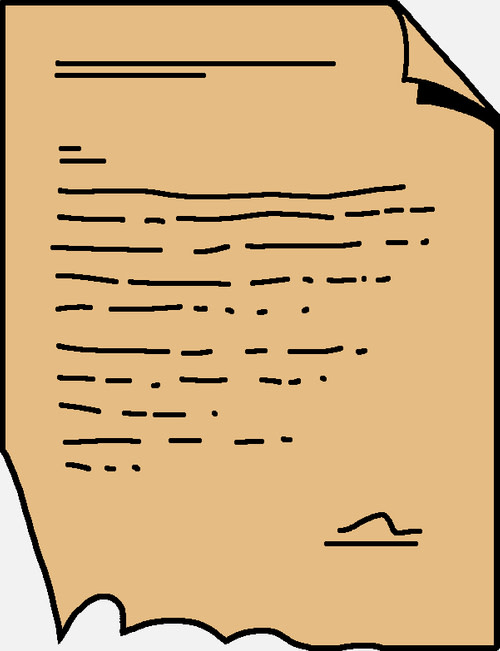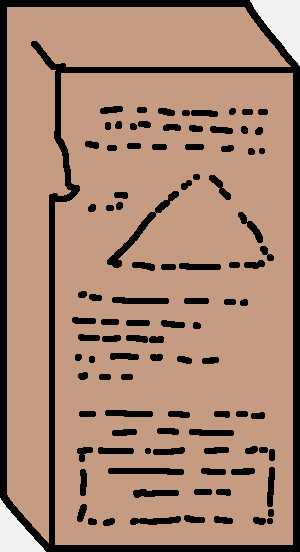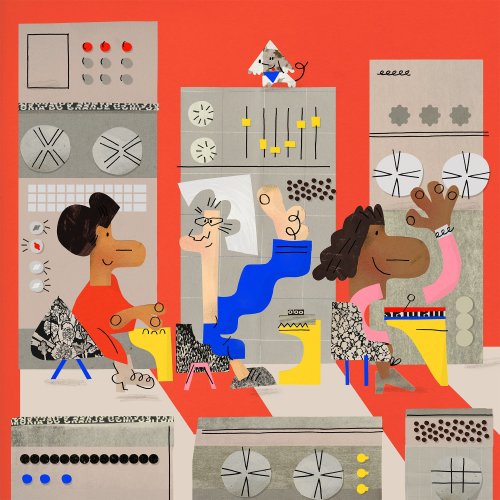Ryan North, a comics writer and creator, once found himself trapped in a puzzle. Not a figurative one, but an accidental, literal one. He and his dog, Noam Chompsky, wound up stuck in a skateboarding pit that was slick with rain. He could not get both himself and his dog out, and he didn’t want to leave Noam behind. Twitter chipped in ideas based on the objects he had on him, and one worked: He clambered out, then used his dog’s leash and an umbrella to pull Noam up to safety.
While this experience wasn’t the impetus for writing his forthcoming book, How to Invent Everything, it did arise out of a similar impulse. A regular writer for the Marvel comic book series The Unbeatable Squirrel Girl and the creator of the long-running web comic Dinosaur Comics, North felt incompetent in a particular regard: “I had a fear/fantasy of being sent back in time and not knowing anything,” he says.
Using knowledge a decently well-informed citizen of the present might have, North’s new book reverse engineers what that person would need to know to create the building blocks of a sustainable, comfortable life in a bygone era. It’s written as an instruction manual for the customer of a time-travel machine who gets stranded in the past.
While North’s book is from the future—it comes out September 2018—it bears an eerie resemblance to historical technical documentation, written without any conceit for the time in which it was published. One famous source of such work is Joseph Moxon, who produced a series from 1677 to 1684 called Moxon’s Mechanick Exercises. Different installments dealt with crafts like smithing, sundial manufacture, and carpentry.
Moxon was a printer, and his most significant volume was the installment on The Doctrine of Handy-Works Applied to the Art of Printing. It effectively told a reader—who was assumed to have already learned a variety of crafts, perhaps from previous volumes, or to be able to hire artisans—how to build an entire printing shop from start to finish. Once complete, the reader could ostensibly just start printing, with the help of the specialized staff the book also described hiring and training.
Moxon’s collection on printing is the first comprehensive guide on the topic, but he wrote out of a growing need to spread technical information in an ever more complicated world, in which traditional structures were breaking down and literacy in Europe had picked up enormously. Cities were growing in size, the demand for production in many fields had increased, and technical information—typically kept close and secret—had to be better disseminated.
Prior to the spread of industrialized processes to nearly every part of the world, masters taught apprentices, who often started at extremely young ages. To master a craft, one learned it firsthand through practice. In Europe, guilds had a stronghold that was eventually fractured by the industrial revolution, which turned workers into low-skilled cogs in a machine instead of craftsmen with finely honed abilities. During that transition, cottage businesses grew larger, and fewer trained workers were available relative to the demand for work.
But Moxon wasn’t a revolutionary of technical communication—there’s a long history of writers attempting to explain things with the detail necessary to understand it fully. A modern coinage, technical communication encompasses scientific writing that can be intended for peers or students, technical descriptions of invented objects, and documentation or how-to manuals.
A writer may explain how the Moon orbits the Earth using words, mathematical formulas, and illustrations. Or they might explain how to build a telescope and then how to use it. Documentation can encompass both the Ikea instructions on how to assemble a dresser and a manual with intricate guidance on how to fold clothes efficiently and place them in its drawers.
Until the mid-1800s, most examples of documentation blurred the line between making something and using it, and often went as far back as raw materials. In a Moxon-like Ikea guide, you might find instructions on how to build a spinning wheel, spin yarn, make fabric, sew clothing, build a dresser, and then, finally, how to put away your clothes.
Where it all began
Noah couldn’t go to Ikea to buy an ark, but he had the next best thing: God’s word. In Genesis, likely composed in the 5th or 6th century BCE, He provides Noah with some pretty sketchy directions:
Make yourself an ark of gopher wood. Make rooms in the ark, and cover it inside and out with pitch. This is how you are to make it: the length of the ark 300 cubits [units of about 18 inches or 45 cm], its breadth 50 cubits, and its height 30 cubits. Make a roof for the ark, and finish it to a cubit above, and set the door of the ark in its side. Make it with lower, second, and third decks.
(English Standard Version of The Holy Bible)
Surely, this would require a call to heavenly customer support for additional details, including diagrams and an explanation of what, exactly, “gopher wood is. And, sure enough, recently deciphered cuneiform tablets reveal more detailed plans for an ark designed to save animals from a flood—derived from Babylonian mythology, they’re dated between 1900 and 1700 BCE, a millennium earlier than the book of Genesis—which its translator calls a detailed construction manual for building an ark along the lines of Noah’s specifications.
The tradition of Genesis and its predecessors aside, Aristotle (4th century BCE) is sometimes credited as the father of technical communications—though not because he ordered anyone to make a boat. Rather, later modern theorists point to his discourse on how to communicate in a rigorous and provable manner. Though he used this as a basis for philosophical and natural observation, he’s credited with providing the scaffolding upon which scientists ultimately built their work.
While plenty of scientific and mathematical observation follows Aristotle, it was only many centuries later that those interested in the antecedents of modern technical writing looked backwards and put a pin in the timeline again for the writing of Muhammad ibn Musa al-Khwarizmi. While there is some dispute over whether he wrote solo or with a co-author, his work in the 12th century CE introduced the use of a zero into mathematical thinking, created algebra, and explored the use of algorithms. (The word “algebra” comes from the Arabic al-jabr, part of the title of one of al-Khwarizmi’s works, which means “the reunion of broken parts,” though it was applied to math only centuries later. “Algorithm” derives from the Latinized form of his name, Algoritmi.)
Al-Khwarizmi’s book on algebra largely dealt with practical matters like inheritance and land surveying, and almost incidentally introduced an entirely new way of using generalized equations to achieve results. While he doesn’t get credit for inventing the algorithm per se—the Greeks had some similar methods—his style of exposition followed by step-by-step instructions has a distinctly modern how-to flavor. His works spread widely and over a long period, setting a tone among scientific writers.
While al-Khwarizmi also wrote about using the astrolabe, an ancient astronomical and navigational tool, we have to look to Geoffrey Chaucer to find out how to employ it. Chaucer is best known as the author of The Canterbury Tales and the first great writer of English literature, but around 1391 he began work on “A Treatise on the Astrolabe.” This is the first clearly defined how-to guide in the English language and one of the earliest that survives in any language. Chaucer compiled details from sources in other languages to produce the guide. Anyone who has read a Dummies book or an O’Reilly tome will find the following perfectly understandable, antiquated grammar and language aside:
2. To knowe the altitude of the sonne or of othre celestial bodies.
Put the ryng of thyn Astrelabie upon thy right thombe, and turne thi lift syde ageyn the light of the sonne; and remewe thy rewle up and doun til that the stremes of the sonne shine thorugh bothe holes of thi rewle. Loke than how many degrees thy rule is areised fro the litel cros upon thin est lyne, and tak there the altitude of thi sonne. And in this same wise maist thow knowe by night the altitude of the mone or of brighte sterres.
Translated into modern prose and how-to style:
How to find the altitude of the sun or other celestial bodies:
1. Put the ring of the astrolabe on your right thumb, and turn your left side towards the sun.
2. Move the rule up and down until the sun’s rays shine through both holes of the rule’s sights.
3. On the small cross on the east line, note the number of degrees the rule has moved. This is the altitude of the sun. You can use this same technique to find the altitude of the moon or of bright stars.
This work was apparently intended for a child named Lewis, either his own son or a friend’s child who died later that year. Chaucer left the manuscript unfinished.
Following Chaucer, and especially by the Renaissance, the scientific form of technical writing starts to proliferate. In the late 1400s and early 1500s, German abbot Johannes Trithemius wrote Steganographia, a three-volume treatise about cryptography, though he described the third volume as covering spirits. The first two, more easily understood, contained instructions on how to build and use ciphers and codes. The third was much more obscure and wasn’t decrypted until 1996. The books didn’t circulate widely until the 1600s, but influenced generations of nascent cryptographers.
By the 1600s, instruction manuals start to become more routine, such as Moxon’s guides, but they are still largely specialized for workers’ roles inside of commercial operations. The notion of documentation for general users takes centuries longer.
The modern era
What’s the purpose of technical documentation, anyway? It’s to show people unfamiliar with the function of something how to get that thing to produce the desired outcome, whether generically or for specific operations. In a 1998 book, From Millwrights to Shipwrights to the Twenty-First Century, R. John Brockmann traces the history of technical communication. He notes that “most items of domestic technology up to the 1850s, except for firearms, were manufactured in the home or on the farm, and most information describing their use was transmitted by word of mouth.”
It takes entering an era of mass production of consumer goods for documentation to shift from industries to the home, especially as new categories of devices appear, like sewing machines and mower-reapers. These very technical kinds of machinery required similarly technical manuals.
Brockmann finds examples of instruction manuals for these kinds of goods from the early 1850s, and notes that in the 1870s, three magazines devoted solely to sewing machines “not only contained general instruction manual standards, but even critiqued the relative effectiveness or ineffectiveness of individual instruction manuals.” He cites Laura Ingalls Wilder’s eighth Little House on the Prairie book, Those Happy Golden Years, in which Pa brings a sewing machine home: “Next week, Ma studied the instruction book and learned to run the machine…” (The book, published in 1943, covers the years 1882 to 1885.)
For a work to qualify as a manual, Brockmann proposes that four elements must be present, which remain characteristic of instruction manuals today: text and graphics must be densely interwoven; text must be packaged into small paragraphs; indexes and tables of contents must organize the material; and the headings must be task-oriented. (One of the victims of desktop publishing is a well-made index, which, to do well, requires hiring an expensive specialist called an indexer, and which many authors and publishers of technical books now avoid.)
Those manuals evolved and reached ever more people, and Brockmann details how the writing style settles down over time—paragraphs, for example, begin to have fewer sentences—while the books shift to more and more explicit instructions. With the spread of the typewriter and other new business tools, the need for such manuals expanded.
The 1893 book A Manual of the Typewriter, written by Isaac Pitman, promises to educate the reader on how to use a typewriter for commercial, literary, legal, dramatic, and “all classes of typewriting work.” It contains this extraordinary and controversial advice:
A full stop at the end of a sentence should be followed by three spaces, as also the note of interrogation [?] and the note of admiration [!]. A colon and a semi colon should always be followed by two spaces and a comma by one.
The introduction of the computer marks a distinct break in documentation history, and the record is clear as to when this occurs. A single person, Joseph D. Chapline, gets the credit. Northrop Aircraft contracted for a computer from what became known as the Eckert–Mauchly Computer Company (EMCC), for which Chapline worked. He was tasked with creating a set of documentation to go along with the BINAC (Binary Automated Computer), which was not just one of the first electronic computers, but also quite a bit more advanced and compact than its predecessors like ENIAC. Northrop was the initial and only customer for BINAC, which was intended to go into mass production and never did.
A history and political science major in college, Chapline studied broadly in the sciences and took two years of advanced writing composition before becoming a research assistant in electrical engineering. With that valuable and disparate background, he followed a mentor to EMCC as a writer and editor.
Chapline spent some of 1948 and much of 1949 planning the form of the documentation for BINAC, which became the subject of an enormous amount of discussion inside the company. While no one understood then that they would come to define a genre, they clearly appreciated that there weren’t a lot of perfect examples from which to draw. Car manuals, already a specialized form of instruction, were seen as one model, but EMCC also expected Northrop’s users to be engineers who would need even more precisely and tightly defined material.
What may have a made difference in the final product was a class Chapline had thrust upon him. In July 1949, with no warning, he was told that he had a room of Northrop engineers to train in the future use of the BINAC. After asking the students, his stakeholders, what they needed, he shifted his approach from what was described as an engineering report—all detail and little instruction—to one that resembled a synthesis of its sewing machine manual predecessors and a dry recitation of the computer’s instructions. Brockmann notes that a version of the manual written before the class didn’t even note the labels on the BINAC’s buttons, only the logical operation of the computer itself. The final version was full of tasks and imperative verbs, too.
Modern technical writers will recognize in Chapline a spiritual predecessor for two reasons: He wasn’t given access to the actual hardware, and he had to write the manual from descriptions written by the engineers doing the building, which were incomplete and could have contained errors. And while EMCC delivered BINAC to Northrop in August of that year, the manual wasn’t finished until December. (By 1964, Chapline had shifted his focus to building and repairing pipe organs.)
This first computer manual, in its genesis of reverse engineering a machine while it was being built, and written to teach others who had never programmed a computer before, brings us back to Ryan North, who has documented the creation of the basic materials of civilization without having made nearly any of them. From the Mosaic God’s ark specifications to North’s helpful hints for the stranded time traveler, documentation has to build a working machine in your mind first, before you can tackle the real one.



